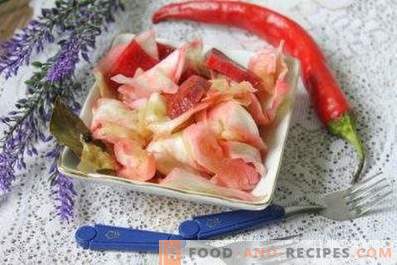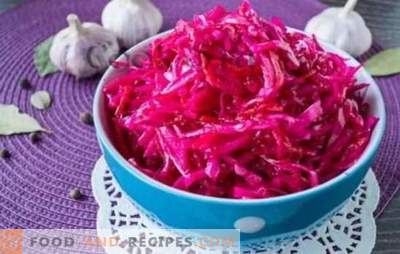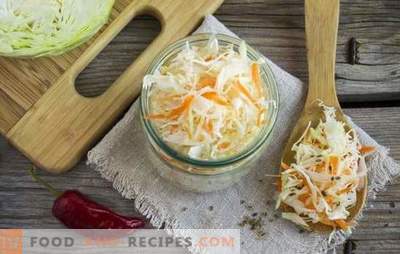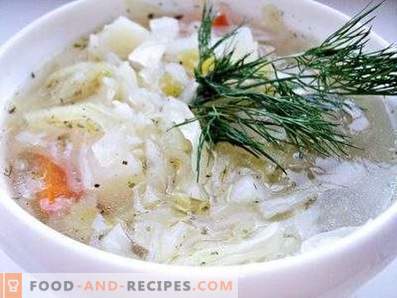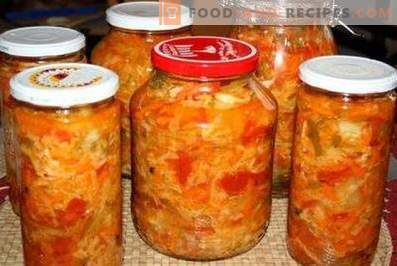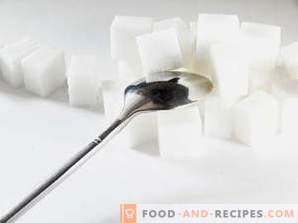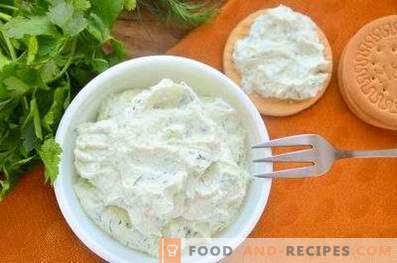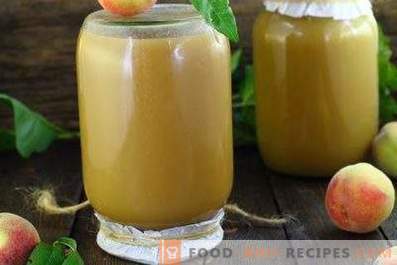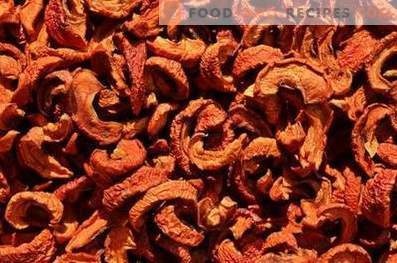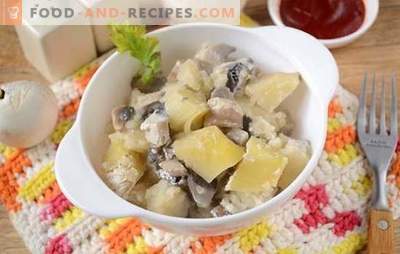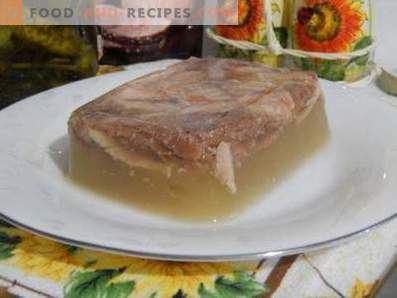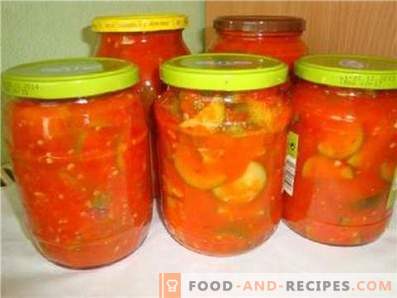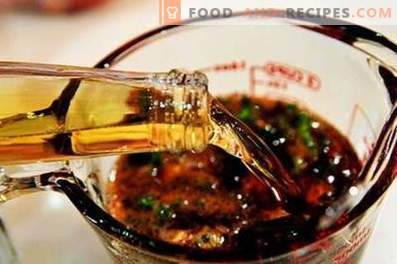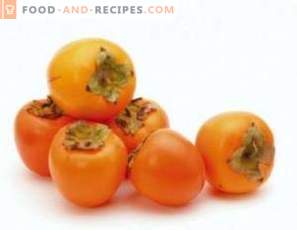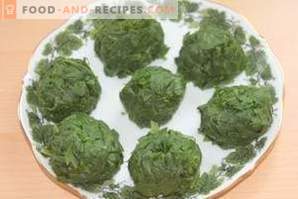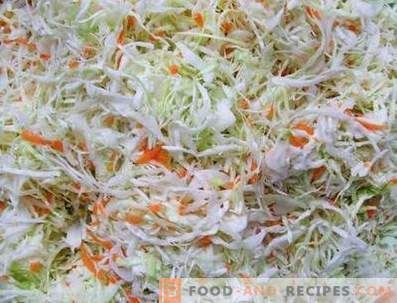
Despite the fact that cabbage does not have a sour taste, it contains a lot of vitamin C. It is especially necessary for a person during the cold season to maintain immunity and successfully resist the flu and cold. Vitamin C is well preserved when sauerkraut and even when it is frozen once. Sauerkraut at home helps to recover from the disease and not get sick at all. In addition, it is a very tasty snack and a base for many hearty dishes.
Peculiarities of cabbage souring at home
The first experience of sauerkraut at home can fail if you do not know the secrets that are well known to experienced housewives:
- Far from all varieties of cabbage are suitable for fermentation. Crop harvested in the summer, for home-made is not suitable. It is better to boil late varieties, preferring the most juicy, cabbages in which are almost completely white. One of the most popular varieties for pickling - "Glory", it is suitable for pickling in a dry way. “Kolobok” and “Amager” salt is better in brine.
- Cut the cabbage for fermentation is necessary with a sharp knife, designed for shredding. But at the same time it is better to make the pieces not quite thin, but about 5 mm. If you make thin small slices, they will become too soft, and sauerkraut is much tastier when it remains crispy.
- Homemade cabbage can be boiled in an enamel saucepan, a bucket, and also in glass jars. If you can, you can try to ferment the cabbage in an oak tub or barrel - it will acquire a unique taste. However, this method is only suitable for those who have a cold cellar to store pickles. Aluminum packaging is not suitable in any case, since this material reacts with lactic acid, which is formed during the fermentation of vegetables.
- Kvass cabbage at room temperature or slightly below it. If the temperature in the room rises above 24 degrees, the cabbage can become slippery. At temperatures below 20 degrees, fermentation will not be intensive enough.
- In order to get enough juice, cabbage must be placed under pressure or tamped very well. This is especially true when sauerkraut dry.
- During fermentation, cabbage needs to be pierced from time to time with a long, sharp knife so that gases will come out of it. Otherwise, the finished snack will not have the most pleasant smell.
- The pickling of cabbage at room temperature lasts 3 days, then you can already eat it, but still it will taste better later: classic recipes provide for fermentation for a week.
- To store sauerkraut is best at a temperature of from 0 to 2 degrees, so the cellar and the refrigerator are ideal places for this. If necessary, cabbage can be frozen. To do this, you need to decompose into packages and put in the freezer. It is advisable to make portions not very large, as cabbage cannot be re-frozen. For the same reason, the balcony is not the most suitable place to store sauerkraut at home.
- Mold may grow on cabbage during storage. Mustard, sugar, which can be sprinkled with the billet at least once a month, helps to prevent its appearance.
With proper preparation and storage, sauerkraut can be eaten for 9 months after preparation. The more it is fresh - the more delicious it is, therefore, usually it does not lie so long.
The classic recipe for sauerkraut: dry method
Composition (5 l):
- white cabbage - 4 kg;
- carrots - 0, 4 kg;
- salt - 80 g;
- sugar - 80 g.
Method of preparation:
- Wash the cabbage, remove the top leaves from it. Slip in 3-4 mm strips.
- Peel carrots, grate on a coarse grater. If desired, you can grate on the grate for making salads in Korean.
- Mix the cabbage and salt thoroughly, kneading it with your hands.
- Sprinkle carrots and sugar, stir.
- Fill with cabbage the container in which you are going to sour it. For this purpose, suitable five-liter saucepan or a clean glass jar of the same capacity.
- When applying cabbage, tamp it more often with your hands or even with your fist. Put the container in the basin, as soon a lot of juice will stand out. Cover the cabbage with clean gauze, if possible, then put the load on top (if you pick it in the can, you can do without the yoke). Leave at room temperature for 3 days. Twice a day, remove the foam, wash gauze and poke the cabbage with a knife.
- Move the container to a cooler place (unheated pantry, to the loggia if there is no frost outside) and wait another 4 days.
- Spread the cabbage in containers that are convenient for further storage at home (if you wish, you can store it in the same way that it is leavened). Store in the basement or refrigerator. Do not forget that sauerkraut can be stored in the freezer.
This recipe makes crispy cabbage with a slight sourness. Before serving, it does not have to be rinsed or soaked — you only need to pour it with oil.
Simple recipe for sauerkraut in brine
Composition (3 liters):
- cabbage - 2 kg;
- carrots - 0, 2 kg;
- water - 1, 5 l;
- salt - 50 g;
- sugar - 50 g;
- bay leaf - 1 pc .;
- black pepper peas - 3 pcs.
Method of preparation:
- Wash vegetables. Cabbage shred, rub carrots.
- Mix cabbage with carrots, put in a jar, carefully tamping it.
- Boil water, dissolve salt and sugar in it.
- Place a bay leaf and peppercorns on top of the cabbage.
- Place the jar on a plate, fill the cabbage with hot pickle so that it pours over the edge.
- Leave the room for 3 days, piercing cabbage several times a day so that unpleasant-smelling gases formed during fermentation are released.
- Put the cabbage in a smaller jar, fill it with the remaining pickle and store in a cool place. At home, this place is usually a refrigerator, although some store pickles in the basement.
Cabbage in brine is cooked simply and quickly, even with inexperienced housewives.
Sauerkraut with apples and lingonberries
Composition (6 liters):
- cabbage - 3, 5 kg;
- apples of sour varieties (ideally Antonov) - 1 kg;
- carrots - 0, 3 kg;
- lingonberries (can be replaced with cranberries) - 100 g;
- rye bread (crackers) - 100 g;
- juniper berries - 5-6 pcs .;
- cumin (seeds) - 5 g;
- sugar - 60 g;
- salt - 80 g;
- currant leaves - 5-6 pcs .;
- vodka - 70 ml.
Method of preparation:
- Prepare a container for pickling cabbage. Two three-liter jars or a large 6-7 liter saucepan will do. Enamelled bucket and oak tub are also suitable containers. The selected container should be well washed and rinsed with boiling water.
- At the bottom of the tub (or other container), place cabbage leaves, after washing them. There, put half the leaves of currants and crusts of bread.
- Chop the cabbage, mix it with salt and wait until the juice starts to stand out.
- Add sugar, grated carrots and cumin seeds, mix.
- Wash apples, cut them into several pieces, cut the core.
- Put a layer of cabbage, filling it with about a third of its capacity. Well seal it.
- Put half the apples, juniper berries, remaining currant leaves.
- Lay out the rest of the cabbage, carefully tamp it.
- Put the remaining apples, pour the lingonberries. Cover with gauze or a clean cloth. Pour on cabbage with vodka and leave to boil at a temperature of 18-22 degrees for 5-7 days. Regularly poke cabbage with a knife or wooden spoon with a long handle.
- Store in a cool storage place.
It is not a shame to saute cabbage sour according to this ancient recipe, even to the holiday table.
Spicy sauerkraut with beets, horseradish, garlic
Composition (5-6 l):
- cabbage - 4 kg;
- beets 0, 4 kg;
- garlic - 2 heads;
- shredded horseradish root - 30 g;
- sugar - 60 g;
- salt - 80 g;
- water - 1 l.
Method of preparation:
- Peel raw beets, wash, cut into large pieces and grate them on a regular grater or grated for Korean salads.
- Pass the garlic through the press.
- Rub horseradish.
- Chop cabbage thinly.
- Mix cabbage with horseradish, beetroot and garlic.
- Boil water, dissolving salt and sugar in it.
- Put the cabbage in a container for pickling (can be expanded in banks). Put the container on a large plate or in the basin.
- Diligently crush the cabbage so that it lies as tight as possible.
- Fill the cabbage with hot pickle.
- If the container dimensions allow, put a plate on top of the cabbage and place a load on it (for example, a jar filled with water).
- 2-3 times a day during the week, remove the load and in several places pierce the cabbage to release the gas formed during fermentation.
- After 7 days, lay the cabbage on the cans and store in the fridge. If cabbage was already boiled in jars, it can be stored right in them.
This recipe produces a spicy snack of beautiful color that will appeal to lovers of savory dishes.
Tender cabbage, pickled with honey
Composition (6 liters):
- cabbage - 4, 5-5 kg;
- salt - 85-90 g;
- honey - 70-75 g;
- bay leaf - 5-6 pcs.
Method of preparation:
- Chop cabbage, mix with salt, remember and wait for the juice to stand out.
- Melt the honey, dissolve it in a minimum amount of water (a quarter cup).
- Fill the cabbage with honey liquid, mix well.
- Sterilize one-liter or larger jars, spread bay leaves on them.
- Tamping down each layer, fill the jars with cabbage so that there is enough space on top to leave the cabbage juice. Banks put on plates.
- Put it in a fairly warm room for 3 days (from 20 to 24 degrees). Pierce cabbage twice a day.
- Drain excess juice, leaving only a small layer of it that covers the cabbage.
- Place a wooden circle or cloth in a large saucepan. Put the cabbage in the pot. Fill the pot with water so that it reaches approximately the level of cabbage in cans.
- Put on a low fire. Sterilize from 20 to 40 minutes depending on the volume of cans.
- Remove the cabbage cans from the pan, roll them up and turn them over.
- Wrap and leave to cool in this form.
- When the banks are cool, you can put them in the closet.
The cabbage made according to this recipe will be tender. It is well kept even at room temperature. This distinguishes this method of its preparation from others.
Video: Very tasty sauerkraut from a family recipe!
Taste, crunch, beauty!
Sauerkraut is tasty by itself, but traditionally it is served as a snack, adding onions cut in thin half-rings and watering with vegetable oil. In addition, homemade pickled cabbage can be used to make solyanka, bigos, cabbage soup and other dishes.
